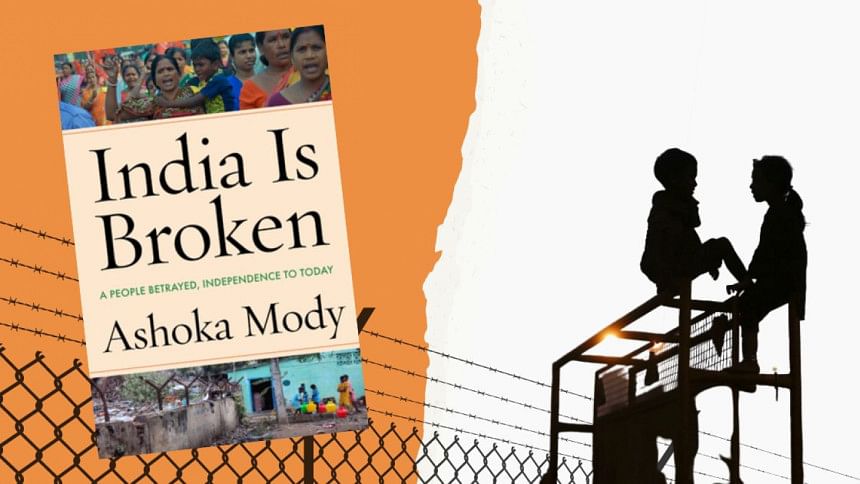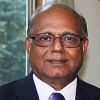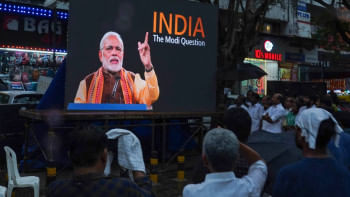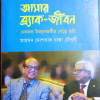Are there any lessons for Bangladesh in Ashoka Mody's ‘India Is Broken’?

A new book by economist Ashoka Mody, visiting professor at Princeton University, titled India Is Broken: A People Betrayed, Independence to Today, has created a stir in the talk show circuit as well as print media in India. Originally published by the Stanford University Press, the paperback version is subtitled And why it is hard to fix. Prof Mody contends that all of India's leaders, from the founding Prime Minister Jawaharlal Nehru to the incumbent Narendra Modi, have placed the country's national development on a wrong trajectory that has failed to meet the needs and aspirations of its people. Is this a storm in a teacup? And are there lessons from it for Bangladesh?
The main, sometimes complex, arguments of the 600-plus-page book have been expressed in simpler terms in Mody's conversations with some of the webinar hosts. Citing Japan's Meiji restoration in the 1860s, post-revolution Russia, and China and South Korea of recent times, he says, "Every successful country has educated its children and has brought its women to the workforce. Quality basic education for all children is the key, there is no exception to this rule." India has failed in this respect, he says.
This is not so for a lack of policy, Mody says. Universal basic education was proclaimed as a policy early on. Though progress was slow, by around 2000 most children were enrolled in school. But, even today, most fifth-graders cannot do second-grade maths or read a second-grade text. After 75 years of independence, more than a third of the young population in India do not complete secondary schooling, and those who complete it, go to colleges where real learning hardly happens.
Taking a historical perspective, Mody asserts that Nehru, despite his progressive ideas about development and his vision about a democratic, egalitarian and secular India, failed to grasp the critical importance of basic education for the young as the building blocks for such a society. He did not heed the messages of Rabindranath Tagore and even Mahatma Gandhi, who had underscored the need for a new education for the new generation infused with a moral purpose and equipped with essential skills and capabilities for life and work.
Nehru opted for creating a number of world-class tertiary institutions concentrating on science and technology in the form of the Indian Institutes of Technology and Indian Institutes of Management, instead of world-class school education. These institutions indeed earned international names. But without the foundation of quality basic education for the population, these became institutions for the elite, supplying personnel to multinational corporations and providing CEOs and top managers to dozens of Fortune-500 companies. Renowned scientist Meghnad Saha said the IITs eviscerated the university system of India.
The benefits of the elite institutions did not reach the masses of India and did not serve the goal of designing and implementing the social and economic development strategies for a democratic, equitable and secular India. Incidentally, Mody and his spouse are both products of IIT and in due course moved to the United States to pursue their illustrious careers.
The educational priorities were of a piece with Nehru's economic development agenda, Mody argues. Nehru's economic planners shunned the job-creating, labour-intensive economic model that could move low-earning and low-productivity agricultural workforce to labour-intensive manufacturing, and take advantage of the post-World War II global export boom. Instead, they opted for government-owned heavy industry, which Nehru called the "temples of new India," to build the base for self-sufficient industrial development. The Chicago school monetarist and Nobel Laureate Milton Friedman was a consultant for India's second five-year plan. Friedman wrote in 1955 opposing the reliance on the extremes of heavy and cottage industry, at the cost of labour-intensive light manufacturing. Both were highly inefficient because the former deployed capital with too little labour – in spite of India's comparative advantage in labour – and the latter used labour with too little capital to be competitive.
Prof Mody argues that the metric of decent job creation – jobs that pay a living wage and secure basic rights and protection of the worker, even in the context of the large informal economy, and not the GDP growth rate – should be the main measure of development.
Nehru, a man of high idealism, fell short in translating his idealism into practical policy and action, as Mody saw it. Nehru deliberately chose to neglect the goals of human development and not do what was needed in basic education and basic healthcare to achieve the human development objectives, though 60 percent of the population remained in abject poverty. The lip service instead of real action on human development intensified with the neoliberal market approach adopted by India since the late 1980s. The acceleration of GDP growth, shifting upwards from the "Hindu rate" of around three percent, validated the approach of jobless, climate-damaging and inequality-generating economic growth along with the neglect of peoples' education, health, decent jobs, clean air and water, and liveable cities.
In the largest democracy in the world, its façade and form existed, not the spirit, and it betrayed the people, asserts Mody, because the education, health and jobs that the people wanted were not delivered. The objective contemporary view of the early post-independence Congress rule, Mody explains, was that the leaders and cadres, with some exceptions, were "a bunch of crooks." Nehru and those who came after him to head the government knew this, but were incapable and unwilling to stand up to this debasement of politics. "The arc of moral degeneration" that arose early widened further over the years.
Moving fast forward to the present, the vaunted Gujarat Model was hyped up with Narendra Modi as the state's chief minister in 2001-14. Since Modi became the prime minister in 2014, it has been presented as the model for India. Prof Mody describes it as "marauding development on steroid." It is not development that serves the people, but a bonanza for business, taxpayers subsidising favourite industrialists who created no jobs, caused great damage to waterways, destroyed livelihood of fishermen, decimated community pastureland, and ravaged mangroves. Gautam Adani is a poster boy of the Gujarat Model. Prof Mody notes that he was a favourite of the regime, whose petrochemical plant built with multiple state subsidies increased the GDP of the state and his own wealth, but created few jobs, raised incomes for only a few common citizens, and chalked up a huge carbon footprint that is not even counted.
Is there a lesson for Bangladesh from the unvarnished account of India's development journey? The trajectory has not been the same. Bangladesh's journey as a nation began a quarter century later in 1971. Then a decade and a half was lost with military rulers holding back normal social, economic and political evolution of a democratic nation. Only in 1990, with the restoration of elected government, did a semblance of normal statecraft resume. It can be said that continuity in governance has existed since 2009 with the current prime minister heading the government.
There are, however, uncanny similarities with India in the broad sweep of economic, education and social development – albeit over a shorter span of time. Most observers would agree that progress in human development in terms of basic education and healthcare has been in terms of numbers with huge deficiencies in quality and outcome. The majority of Class 5 students not being able to do Class 2 level reading or maths is a familiar story in Bangladesh. Jobless growth, unliveable cities, polluted air and water, pervasive corruption, growing inequality and polarised politics are our stories as well. So is the single-minded focus on GDP growth, with not enough attention to jobs, climate, the distribution effects and the destructive impact of crony capitalism.
In his webinar, citing examples of East Asian countries, Prof Mody also mentioned Bangladesh's progress in some of the social indicators, moving ahead of India, especially in women's participation in the workforce and their access to education.
What is Prof Mody's response to the question – how can it be fixed? His answer is conditional. Those who believe in India's dream have to devote themselves to bringing about dramatic change in the course of development – creating jobs and protecting the environment, empowering people with real basic education and health outcomes. Effective actions in these areas, Mody argues, call for massive decentralisation of governance, bringing decision-making and accountability closer to the beneficiaries, giving them a say in these matters. Those who believe in Bangladesh's dream would do well to pay heed to the same counsel.
Dr Manzoor Ahmed is professor emeritus at Brac University, chair of Bangladesh ECD Network, and vice-chair of Campaign for Popular Education (CAMPE). Views expressed in this column are the author's own.

 For all latest news, follow The Daily Star's Google News channel.
For all latest news, follow The Daily Star's Google News channel. 









Comments